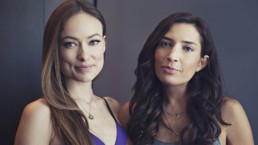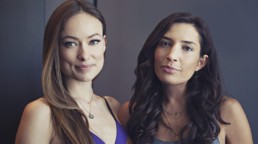Director Reed Morano on ‘Meadowland’
"What was really great was that the cast brought their faith to the project- believing that I could make something they would be proud of." -Reed Morano
Reed Morano may be a first-time director, but don’t let that fool you into thinking she doesn’t know what she’s doing behind the lens. Morano, a noted cinematographer whose past works include Kill Your Darlings and Frozen River, joined the American Society of Cinematographers in 2013. She is currently the youngest member, and one of only 14 women, in an organization of about 345 members. As if that is not impressive enough, she still finds time to raise her two children and direct her first feature film, Meadowland. Talk about a Superwoman! I was able to chat exclusively with Morano, from her press day in New York, about her similarities to lead actress and friend Olivia Wilde, her “elegant naturalism” vibe, and which A-list actors gave her the courage to make the film. We begin:
What is it like seeing these posters for Meadowland all over town with an all-star cast, and then seeing your name, “Directed by Reed Morano?”
It’s pretty cool, I’m not gonna lie. That’s a good question because it’s one of those things that doesn’t get talked about much, but it is so real. I’m sitting in the conference room right now and the poster is sitting in the window and I have one at home now, and I’m just like, ‘This is so weird, how did this happen?’ ‘How did I get so lucky?’
I thought the film was so interesting because it is every parent’s worst nightmare, but the way it was shot made it look as if it was a dream. It is beautiful. What was your inspiration for the look of the film?
I always knew I wanted it to feel naturalistic. Something I was striving for could be described as elegant naturalism where it wouldn’t feel rough, but you would feel really close to the characters. The script dictated to me where the visuals needed to go in order to make the film as successful as possible because you need to feel emotionally connected to these characters because if there is a wall up between the audience and Sarah and Phil then it’s never going to work. They’re not going to have the impact that they need to have. What they’re going through is difficult and they do some things that make them hard to like, but then at the same time, can you blame them?
Rather than shoot this in a straightforward manner, I feel like when people go through tragedy the world often seems turned upside down. For me when my dad passed away when I was 18, it felt like I was walking around in the Twilight Zone. I had tunnel vision. I thought it would be interesting to try to convey what it feels like when you’ve been through something like this visually on screen. I didn’t really know how. My editor Madeleine Gavin and I often described the film as a fever dream, it becomes almost hallucinatory at times.

Did you see yourself in Olivia Wilde when you cast her as Sarah?
You know what’s funny, that wasn’t the reason why but I think there are a lot of similarities about Olivia and I in our attitude and the way we look at the world. It’s an honor for me to say that because I put her on this pedestal of one of the greatest people I’ve ever met and had the pleasure of working with. When I met Olivia, she was trying more than anything to take herself out of the box that she’s been put in and I felt like I was trying to do the same thing. At the time we cast Olivia, she wasn’t a mom yet but she wanted [this part] so bad. She would force herself to go to this place that is really hard to even fathom. As luck would have it, she ended up getting pregnant while we were trying to finance the movie. She thought I was going to recast and I was like, ‘Are you crazy? We’re doing this, together till the end.’
Your supporting cast is also incredible, what did they bring to the screen that was unique to them?
They each brought a little bit of themselves to their roles. With Luke [Wilson] I had worked with him before on The Skeleton Twins, but just being the person he was, I knew he could do this. I feel like there’s this untapped side of him that is so interesting and intriguing and I wanted to see him go there. Same with Elisabeth Moss. That was a role that was appealing to me because she’s been playing certain types of characters and hadn’t played a role like this. Of course in casting they wanted me to look at the usual suspects for the role of Adam’s drug addict foster mom, but we’ve seen this before. Unfortunately, actors can be stereotyped and the thing they all had in common was that they were all deeply connected. What was really great was that the cast brought their faith to the project- believing that I could make something they would be proud of.

Do you have a favorite shot from the film?
You know, it’s funny, it’s hard to separate myself from favorite shots and favorite scenes because now falling into the director roll, I can’t separate myself from my favorite moments in the movie. From a cinematographer’s perspective, I have some favorite shots but I prioritized the story and the acting and the narrative and didn’t want to pay attention to the cinematography because I knew it would fall into place and I didn’t need to worry about it. But I do have shots that I love. There’s one shot in the beginning after Jesse goes missing- the clouds outside of the house right before you cut to the scene where Sarah and Phil are having dinner with their friends. The clouds have this surreal, most bizarre color. What I like about that is, everything in the film is supposed to feel weird and surreal, and those clouds and its color was real.
Speaking of color, I thought it was interesting how Sarah wore a yellow sweatshirt throughout the film. Yellow usually symbolizes happiness and joy, basically the exact opposite of how she is actually feeling.
Yes, it was definitely intentional. I personally went through some stuff where I was sick for awhile and the last thing I wanted to do was dress up and look nice. I wanted to do the bare minimum. I knew that whatever Sarah was going through was probably a million times worse than what I went through. The obvious choice would be to have her wear a black hoodie or something like that. My costume designer, Olivia and I were all in agreement that whatever Sarah had before Jesse went missing is all she has now because she would have never gone shopping since then. She had a yellow sweatshirt because everything was fine. I also like the idea of challenging the obvious in every way.

Was it a challenging transition going from cinematographer to director?
It was easier to get the movie made. People had a little more faith in me because of the number of sets I had been on, so I had a bit of a leg up. Figuring out what to do as a director was a big unknown for me, like how do you speak to actors? How do you get out of them what you want out of them? Getting through Day 1 with both the responsibility of directing and dp’ing simultaneously, I was like, ‘What the fuck am I doing?’
Does the success of Meadowland scare you, or excite you, as you take on your next film?
That’s an interesting question, I haven’t been asked that before. I don’t know how high I’ve set the bar. I feel like we’ve made the best movie we could make, but yeah, it is a little intimidating going to the next project but then also it’s empowering. I could take all the things I learned on this movie to the next level.
Morgan Rojas
Certified fresh. For disclosure purposes, Morgan currently runs PR at PRETTYBIRD and Ventureland.


